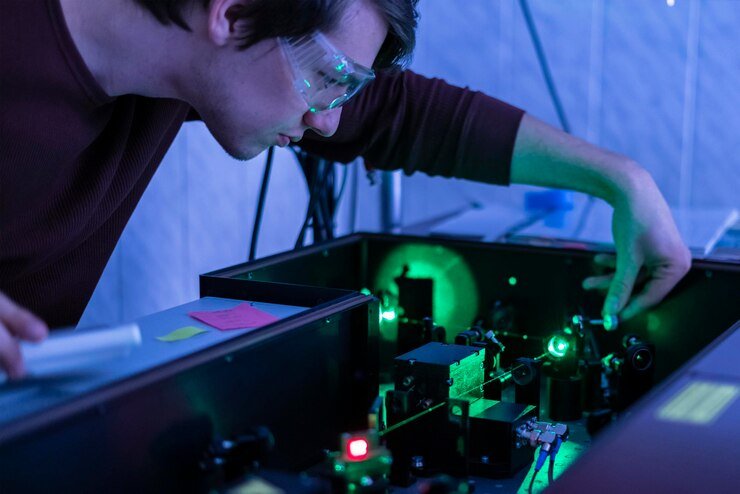In the rapidly advancing world of industrial technology, the introduction of portable fiber lasers represents a significant leap forward. These compact, yet powerful devices are revolutionizing the field of material processing and have become a crucial component of modern automation equipment. Portable fiber lasers combine the precision and efficiency of traditional laser systems with the flexibility and convenience needed for diverse applications, making them indispensable in today’s industrial landscape.
What is a Portable Fiber Laser?
A portable fiber laser is a compact laser system that utilizes optical fiber as its medium to generate and deliver high-intensity laser beams. Unlike traditional laser systems that use gas or crystal mediums, fiber lasers offer numerous advantages, including enhanced efficiency, reduced maintenance, and greater flexibility. Their portability makes them ideal for on-site applications, where transporting large and heavy equipment would be impractical.
Key Features of Portable Fiber Lasers
- Compact Design
- Feature: Lightweight and small footprint.
- Benefit: Easy to transport and deploy in various locations, providing flexibility for fieldwork and confined spaces.
- High Precision
- Feature: Ability to deliver finely focused laser beams.
- Benefit: Enables accurate cutting, engraving, and marking, essential for intricate designs and detailed work.
- Energy Efficiency
- Feature: Low power consumption compared to traditional laser systems.
- Benefit: Reduces operational costs and supports sustainable practices by minimizing energy usage.
- Robust and Reliable
- Feature: Built to withstand harsh industrial environments.
- Benefit: Ensures durability and consistent performance in demanding conditions, reducing downtime.
- Ease of Integration
- Feature: Compatibility with existing automation equipment.
- Benefit: Facilitates seamless integration into automated production lines, enhancing productivity and efficiency.
Applications of Portable Fiber Lasers in Automation Equipment
Portable fiber lasers are versatile tools that find applications across a wide range of industries. Their integration into automation equipment enhances capabilities in various material processing tasks, including:
- Metal Cutting
- Application: Precise cutting of metals like stainless steel, aluminum, and copper.
- Advantage: Produces clean, burr-free cuts with minimal heat-affected zones, crucial for high-quality finishes in manufacturing.
- Marking and Engraving
- Application: Permanent marking and engraving on materials such as metals, plastics, and ceramics.
- Advantage: Ideal for creating serial numbers, barcodes, and intricate designs, offering durability and resistance to wear.
- Welding
- Application: Welding of thin materials and intricate components.
- Advantage: Provides strong, precise welds with minimal distortion, important for applications in electronics and precision engineering.
- Surface Cleaning
- Application: Removal of rust, paint, and other surface contaminants.
- Advantage: Offers a non-contact, eco-friendly alternative to traditional abrasive cleaning methods, preserving the integrity of the material.
- Drilling
- Application: Creating small, precise holes in various materials.
- Advantage: Ensures high precision and control, suitable for applications in aerospace, automotive, and electronics industries.
- 3D Printing and Rapid Prototyping
- Application: Laser sintering and melting for additive manufacturing.
- Advantage: Enables the creation of complex geometries and rapid prototyping, enhancing innovation and reducing development time.
Benefits of Using Portable Fiber Lasers in Automation Equipment
The integration of portable fiber lasers into automation equipment offers several compelling benefits, making them an attractive option for modern industrial applications:
- Enhanced Flexibility
- Benefit: The portability of these lasers allows them to be easily moved and deployed in various locations, supporting on-site repairs, custom installations, and field services.
- Increased Productivity
- Benefit: Their high processing speeds and precision reduce cycle times and improve throughput, contributing to faster production rates and shorter lead times.
- Cost Savings
- Benefit: Low maintenance requirements and reduced energy consumption lower operational costs, while their durability minimizes the need for frequent replacements or repairs.
- Improved Quality
- Benefit: The precision and control offered by fiber lasers result in high-quality finishes and accurate material processing, enhancing the overall quality of the products.
- Sustainability
- Benefit: Energy-efficient operation and the ability to replace traditional, resource-intensive processes with cleaner alternatives support environmental sustainability.
Technological Advancements Driving Portable Fiber Lasers
The development of portable fiber lasers has been driven by several key technological advancements, each contributing to their effectiveness and integration into automation equipment:
- Advancements in Fiber Optics
- Development: Improved optical fibers with higher power handling capabilities and better beam quality.
- Impact: Enhances the performance and efficiency of fiber lasers, allowing for more precise and powerful laser applications.
- Innovative Cooling Systems
- Development: Efficient cooling mechanisms that maintain optimal operating temperatures.
- Impact: Prevents overheating and ensures consistent performance, even in extended operations or high-power applications.
- Integrated Control Systems
- Development: Advanced control systems with real-time monitoring and feedback.
- Impact: Provides greater control over laser parameters, enabling fine-tuning for specific applications and improving process reliability.
- Improved Beam Delivery
- Development: Enhanced beam delivery systems with flexible fibers and adaptive optics.
- Impact: Facilitates easier integration with automation equipment and allows for complex processing tasks with greater accuracy.
- User-Friendly Interfaces
- Development: Intuitive interfaces and software for easier operation and programming.
- Impact: Reduces the learning curve and allows operators to quickly adapt to the system, enhancing productivity and reducing errors.
Challenges and Future Prospects
While portable fiber lasers offer numerous benefits, they also present certain challenges that need to be addressed to fully realize their potential:
- Initial Investment Costs
- Challenge: The upfront cost of acquiring high-quality portable fiber lasers can be significant.
- Solution: As technology advances and production scales up, prices are expected to decrease, making these systems more accessible.
- Integration Complexity
- Challenge: Integrating portable fiber lasers into existing automation equipment can be complex, requiring technical expertise.
- Solution: Ongoing advancements in plug-and-play solutions and modular designs are making integration easier and more streamlined.
- Operator Training
- Challenge: Operators need training to effectively use and maintain portable fiber lasers.
- Solution: Enhanced training programs and user-friendly interfaces are helping to reduce the skill gap and improve adoption.
The future of portable fiber lasers looks promising, with continuous improvements in technology expected to enhance their capabilities and applications. Innovations in laser power, beam quality, and automation integration are likely to drive further advancements, solidifying the role of portable fiber lasers as essential components of automation equipment.
Conclusion
Portable fiber lasers represent a significant innovation in the field of automation equipment, offering unmatched flexibility, precision, and efficiency. Their compact design and advanced capabilities make them ideal for a wide range of applications, from metal cutting and welding to marking and surface cleaning. As technology continues to evolve, portable fiber lasers will play an increasingly important role in modern manufacturing, driving improvements in productivity, quality, and sustainability. For industries looking to stay competitive and embrace cutting-edge solutions, investing in portable fiber lasers is a strategic move that promises substantial returns.













+ There are no comments
Add yours